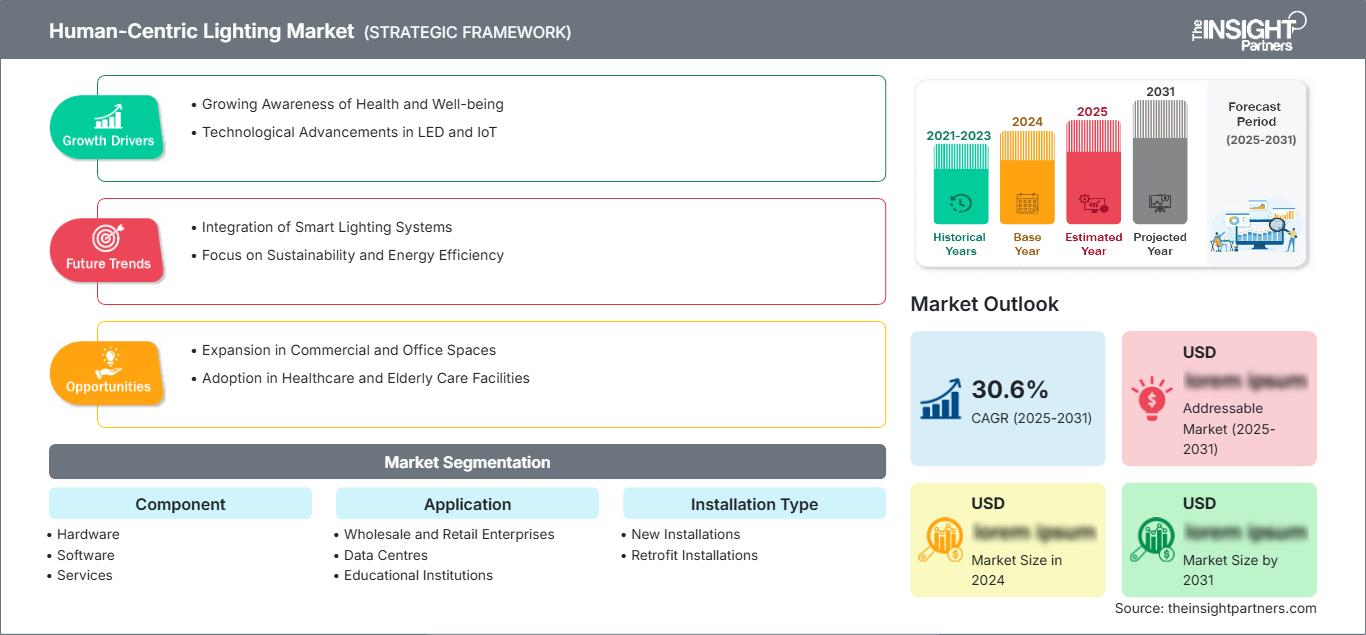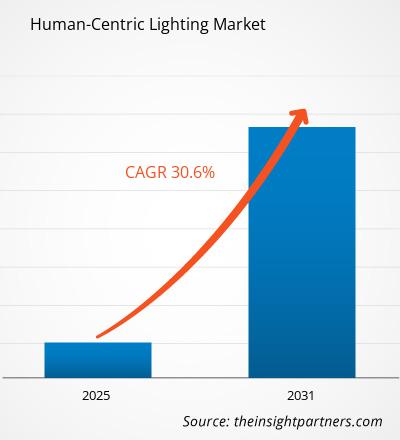Le marché de l'éclairage centré sur l'humain devrait enregistrer un TCAC de 30,6 % entre 2025 et 2031, avec une taille de marché passant de XX millions de dollars américains en 2024 à XX millions de dollars américains d'ici 2031.
Le rapport est segmenté par composant (matériel, logiciel, services) ; application (entreprises de gros et de détail, centres de données, établissements d'enseignement, résidentiel, soins de santé, hôtellerie, autres) ; type d'installation (nouvelles installations, installations de rénovation). L'analyse mondiale est ensuite ventilée au niveau régional et par principaux pays. Le rapport offre la valeur en USD pour l'analyse et les segments ci-dessus.
Objectif du rapport
Le rapport sur le marché de l'éclairage centré sur l'humain de The Insight Partners vise à décrire le paysage actuel et la croissance future, les principaux facteurs moteurs, les défis et les opportunités. Cela fournira des informations à diverses parties prenantes commerciales, telles que :
- Fournisseurs/fabricants de technologies : pour comprendre l’évolution de la dynamique du marché et connaître les opportunités de croissance potentielles, leur permettant de prendre des décisions stratégiques éclairées.
- Investisseurs : pour effectuer une analyse complète des tendances concernant le taux de croissance du marché, les projections financières du marché et les opportunités qui existent tout au long de la chaîne de valeur.
- Organismes de réglementation : pour réglementer les politiques et surveiller les activités du marché dans le but de minimiser les abus, de préserver la confiance des investisseurs et de maintenir l’intégrité et la stabilité du marché.
Composant de segmentation du marché de l’éclairage centré sur l’humain
- Matériel
- Logiciel
- Services
Application
- Entreprises de gros et de détail
- Centres de données
- Éducation Institutions
- Résidentiel
- Soins de santé
- Hôtellerie
- Autres
Type d'installation
- Nouvelles installations
- Installations modernisées
Géographie
- Amérique du Nord
- Europe
- Asie-Pacifique
- Amérique du Sud et centrale
- Moyen-Orient et Afrique
Vous bénéficierez d’une personnalisation sur n’importe quel rapport - gratuitement - y compris des parties de ce rapport, ou une analyse au niveau du pays, un pack de données Excel, ainsi que de profiter d’offres exceptionnelles et de réductions pour les start-ups et les universités
Marché de l'éclairage centré sur l'humain: Perspectives stratégiques

- Obtenez les principales tendances clés du marché de ce rapport.Cet échantillon GRATUIT comprendra une analyse de données, allant des tendances du marché aux estimations et prévisions.
Moteurs de croissance du marché de l'éclairage centré sur l'humain
- Prise de conscience croissante de la santé et du bien-être : La prise de conscience croissante de l'impact de l'éclairage sur la santé et le bien-être humains est un moteur clé du marché de l'éclairage centré sur l'humain (HCL). Des études soulignant l'impact de l'éclairage sur les rythmes circadiens, l'humeur, la productivité et la qualité du sommeil encouragent l'adoption de solutions HCL. Ces systèmes, qui ajustent l'éclairage en fonction des schémas de lumière naturelle et de l'activité humaine, sont intégrés aux lieux de travail, aux établissements de santé et aux foyers pour améliorer le bien-être général.
- Progrès technologiques en matière de LED et d'IoT : Les progrès de la technologie LED et l'intégration de l'Internet des objets (IoT) propulsent le marché de l'éclairage centré sur l'humain. Les LED offrent une flexibilité en termes de température et d'intensité de couleur, tandis que l'intégration de l'IoT permet un contrôle et une surveillance en temps réel. Ces innovations facilitent la mise en œuvre de systèmes d'éclairage dynamiques et économes en énergie qui répondent aux besoins de santé humaine, stimulant ainsi la demande de solutions HCL.
Tendances futures du marché de l'éclairage centré sur l'humain
- Intégration de systèmes d'éclairage intelligents : la tendance vers un éclairage intelligent et connecté s'accélère sur le marché HCL. Les systèmes d'éclairage centrés sur l'humain sont de plus en plus intégrés aux écosystèmes de maisons et de bureaux intelligents, où ils peuvent être contrôlés via des applications, des assistants vocaux ou des programmations automatisées. Cette tendance améliore l'expérience utilisateur en ajustant l'éclairage en fonction de l'heure de la journée, des préférences individuelles ou des facteurs environnementaux, favorisant ainsi la santé et la productivité.
- Focus sur la durabilité et l'efficacité énergétique : une tendance clé sur le marché HCL est l'importance croissante accordée à la durabilité et aux solutions économes en énergie. Les systèmes d'éclairage centrés sur l'humain, en particulier ceux utilisant la technologie LED, sont économes en énergie et respectueux de l'environnement. Ces systèmes sont conçus pour réduire la consommation d'énergie tout en offrant un éclairage optimal pour la santé humaine, conformément à la tendance mondiale vers des pratiques de construction et une gestion de l'énergie plus durables.
Opportunités du marché de l'éclairage centré sur l'humain
- Expansion dans les espaces commerciaux et de bureaux : La demande d'amélioration du bien-être et de la productivité des employés représente une opportunité significative pour le marché de l'éclairage centré sur l'humain dans les environnements commerciaux et de bureaux. Alors que les entreprises reconnaissent de plus en plus les avantages d'un éclairage qui s'adapte aux besoins des employés, l'utilisation de solutions HCL dans les bureaux, les salles de réunion et les espaces collaboratifs devrait augmenter.
- Adoption dans les établissements de santé et de soins aux personnes âgées : Le secteur de la santé, en particulier dans les hôpitaux, les cliniques et les établissements de soins aux personnes âgées, offre des opportunités significatives pour le marché de l'éclairage centré sur l'humain. Les systèmes HCL qui prennent en charge les rythmes circadiens peuvent contribuer à améliorer le temps de récupération des patients, la qualité du sommeil des patients âgés et la réduction du stress. Cela favorise l'adoption d'un éclairage centré sur l'humain dans les environnements médicaux et de soins pour de meilleurs résultats de santé.
Aperçu régional du marché de l'éclairage centré sur l'humain
Les tendances et facteurs régionaux influençant le marché de l'éclairage centré sur l'humain tout au long de la période de prévision ont été analysés en détail par les analystes de The Insight Partners. Cette section aborde également les segments et la géographie du marché de l'éclairage centré sur l'humain en Amérique du Nord, en Europe, en Asie-Pacifique, au Moyen-Orient et en Afrique, ainsi qu'en Amérique du Sud et en Amérique centrale.
Portée du rapport sur le marché de l'éclairage centré sur l'humain
| Attribut de rapport | Détails |
|---|---|
| Taille du marché en 2024 | US$ XX million |
| Taille du marché par 2031 | US$ XX Million |
| TCAC mondial (2025 - 2031) | 30.6% |
| Données historiques | 2021-2023 |
| Période de prévision | 2025-2031 |
| Segments couverts |
By Composant
|
| Régions et pays couverts | Amérique du Nord
|
| Leaders du marché et profils d'entreprises clés |
|
Densité des acteurs du marché de l'éclairage centré sur l'humain : comprendre son impact sur la dynamique des entreprises
Le marché de l'éclairage centré sur l'humain connaît une croissance rapide, portée par une demande croissante des utilisateurs finaux, due à des facteurs tels que l'évolution des préférences des consommateurs, les avancées technologiques et une meilleure connaissance des avantages du produit. Face à cette demande croissante, les entreprises élargissent leur offre, innovent pour répondre aux besoins des consommateurs et capitalisent sur les nouvelles tendances, ce qui alimente la croissance du marché.

- Obtenez le Marché de l'éclairage centré sur l'humain Aperçu des principaux acteurs clés
- Analyse historique (2 ans), année de base, prévision (7 ans) avec TCAC
- Analyse PEST et SWOT
- Taille du marché Valeur / Volume - Mondial, Régional, Pays
- Industrie et paysage concurrentiel
- Ensemble de données Excel
Rapports récents
Témoignages
Raison d'acheter
- Prise de décision éclairée
- Compréhension de la dynamique du marché
- Analyse concurrentielle
- Connaissances clients
- Prévisions de marché
- Atténuation des risques
- Planification stratégique
- Justification des investissements
- Identification des marchés émergents
- Amélioration des stratégies marketing
- Amélioration de l'efficacité opérationnelle
- Alignement sur les tendances réglementaires




















 Obtenez un échantillon gratuit pour - Marché de l'éclairage centré sur l'humain
Obtenez un échantillon gratuit pour - Marché de l'éclairage centré sur l'humain